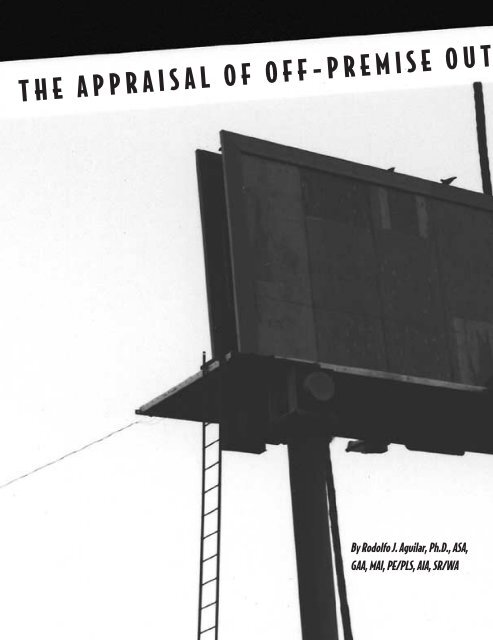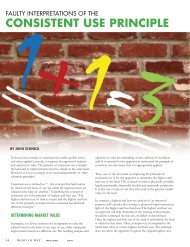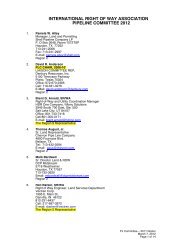Rodolfo J. Aguilar, Ph.D., ASA, GAA - International Right of Way ...
Rodolfo J. Aguilar, Ph.D., ASA, GAA - International Right of Way ...
Rodolfo J. Aguilar, Ph.D., ASA, GAA - International Right of Way ...
You also want an ePaper? Increase the reach of your titles
YUMPU automatically turns print PDFs into web optimized ePapers that Google loves.
THE APPRAISAL OF OFF-PREMISE OUT<br />
By <strong>Rodolfo</strong> J. <strong>Aguilar</strong>, <strong>Ph</strong>.D., <strong>ASA</strong>,<br />
<strong>GAA</strong>, MAI, PE/PLS, AIA, SR/WA
DOOR ADVERTISING BILLBOARDS<br />
An on-slaught <strong>of</strong> articles on the appraisal <strong>of</strong> billboard structures has recently hit the<br />
academic-trade press 1, 2, 3 . The acknowledged “bible” <strong>of</strong> billboard appraisal is the<br />
textbook by Donald T. Sutte, Jr., The Appraisal <strong>of</strong> Outdoor Advertising Signs 4 ,<br />
published by the Appraisal Institute in 1994 5 . Since its publication, praises and<br />
vituperations have been showered on Sutte’s textbook. In my opinion, Sutte’s<br />
theory and conclusions are correct and valid, and fairly outline a logical approach to the<br />
valuation <strong>of</strong> <strong>of</strong>f-site outdoor advertising structures. However, one must not forget that the<br />
purpose <strong>of</strong> an appraisal is to develop the most reasonable estimate <strong>of</strong> the price (in terms<br />
<strong>of</strong> money) that a willing buyer would pay a willing seller as full compensation for the<br />
seller’s property, that is, its market value. In the case <strong>of</strong> a billboard, the property rights<br />
appraised are the fee simple interest in the structure, usually located on leased land, i.e.,<br />
a leasehold, the land lease, and the permits.<br />
On-Premise Versus Off-Premise Advertising<br />
On-premise and <strong>of</strong>f-premise signs are defined as follows:<br />
On-premise Signs. Any sign that disseminates information that directly relates to the<br />
use <strong>of</strong> the property on which it is located and is not a separate and distinct use.<br />
Off-premise Outdoor Advertising encompasses any out-door sign, display, figure,<br />
painting, drawing, message, plaque, poster, billboard, or any other thing which is<br />
designed, intended or used to advertise or inform, any part <strong>of</strong> which advertising or<br />
information content is visible from any place on the main travel way <strong>of</strong> the interstate<br />
system or any thoroughfare. The term “<strong>of</strong>f-premise outdoor advertising,” however,<br />
does not include signs advertising or identifying on-premise activities, and such<br />
on-premise advertising or identifying structures shall not be considered “outdoor<br />
advertising” structures for any purpose.<br />
The purpose <strong>of</strong> this article is to clarify and revisit the methods by which the market<br />
value <strong>of</strong> <strong>of</strong>f-premise outdoor advertising structures is estimated.<br />
The Plant<br />
It is not uncommon for an outdoor advertising company to have an <strong>of</strong>fice and main<br />
shop facility in addition to its investment in the sign structures. The sign structures are<br />
commonly referred to in the industry as “The Plant.” The plant consists only <strong>of</strong> the sign<br />
structures (the five basic types <strong>of</strong> advertising signs described below) which are normally<br />
located on leased sites. The plant does not include the company <strong>of</strong>fice(s) and main shop<br />
facility.<br />
General Classification <strong>of</strong> Outdoor Advertising Structures<br />
Outdoor advertising structures are generally classified as:<br />
1. Permanent Paints. These structures frequently differ in size, shape and income.<br />
Usually, they have fixed term contracts for the advertising<br />
space. The message is permanently painted or printed on the<br />
physical substrate face <strong>of</strong> the sign or on a vinyl.<br />
2. Rotary Bulletins. These signs have consistent face sizes<br />
with varying types <strong>of</strong> structures. The advertising copy is<br />
painted on panels or printed on vinyl, which are rotated<br />
or moved between several locations at frequent intervals<br />
during the term <strong>of</strong> the contract with the advertiser. The<br />
standard size <strong>of</strong> rotary bulletins is 14 feet by 48 feet, and<br />
may include cutouts or embellishments.<br />
PHOTOGRAPHY BY MARGARET SISON
OFF-PREMISE OUTDOOR ADVERTISING<br />
3. Spectaculars or Special Signs. These<br />
are signs <strong>of</strong> unusual size and shape,<br />
located on prime sites. The displays<br />
are <strong>of</strong>ten specially treated.<br />
4. The Poster. A standard advertising<br />
copy is printed on posting paper and<br />
pasted on the face <strong>of</strong> the sign. Poster<br />
copies are standard throughout the<br />
industry. They are approximately 12<br />
feet high by 24 feet long. Several<br />
identical poster copies may be<br />
purchased by a single advertiser and<br />
displayed throughout the market to<br />
achieve a targeted showing or coverage.<br />
5. The Junior Poster. This display is<br />
approximately 6 feet high by 12 fee<br />
long. It is small-standardized advertising<br />
copy, printed on posting paper<br />
and pasted on the face <strong>of</strong> the sign and<br />
used frequently to achieve a targeted<br />
showing or coverage.<br />
Components <strong>of</strong> Individual Sign Structures<br />
The typical components <strong>of</strong> an indivi<br />
ual sign are:<br />
• Section<br />
• Stringer<br />
• Embellishment or extension<br />
• Rails<br />
• Base<br />
• Catwalk<br />
• Footings<br />
• Illumination, type and description<br />
• Uprights, super-structure (height<br />
measured as HAGL, height above<br />
ground level)<br />
• Trim, etc.<br />
Of course, the subject property also<br />
includes the right <strong>of</strong> possession (leasehold)<br />
and the right to operate (permits).<br />
Outdoor Advertising Showing Strategies<br />
Generally speaking, the advertiser is<br />
concerned with getting the message<br />
disseminated throughout a “geographic<br />
area,” rather than in a single location.<br />
Consequently, the client normally rents<br />
several panels simultaneously to insure<br />
adequate area coverage. Due to their<br />
nature, rotary bulletins can be specifically<br />
designated because the display is<br />
moved from one location to another,<br />
thus allowing the advertiser maximum<br />
“showing” coverage.<br />
Real Estate, Real Property and Personal Property<br />
According to the Dictionary <strong>of</strong> Real<br />
Estate Appraisal 6 , published by the<br />
Appraisal Institute, the following are the<br />
accepted definitions <strong>of</strong> real estate, real<br />
property and personal property:<br />
Real Estate. <strong>Ph</strong>ysical land and appurtenances<br />
attached to the land, e.g.,<br />
structures. An identified parcel or<br />
tract <strong>of</strong> land, including improvements,<br />
if any.<br />
Real Property. All interests, benefits,<br />
and rights inherent in the ownership<br />
<strong>of</strong> physical real estate. In some states,<br />
real property is defined by statute and<br />
is synonymous with real estate.<br />
Personal Property. Identifiable<br />
portable and tangible objects that are<br />
considered by the general public to<br />
be “personal,” e.g., furnishings, art<br />
work, antiques, gems and jewelry,<br />
W<br />
O<br />
W<br />
ant Your Ad In Color Like This One?<br />
Well it can.<br />
Advertisers now have the option to<br />
place a 4-color ad in <strong>Right</strong> <strong>of</strong> <strong>Way</strong><br />
magazine.<br />
Bring out the colors that represent<br />
and project a more dynamic image <strong>of</strong><br />
your company. Contact Mary Anne<br />
Modina for quotes.<br />
(310) 538-0233 Ext. 130<br />
modina@irwaonline.org<br />
Discover the difference color can make!<br />
14<br />
SEPTEMBER/OCTOBER 2000 • RIGHT OF WAY
collectibles, machinery and equipment;<br />
all property that is not classified as<br />
real estate (USPAP 7 , 1999 edition).<br />
Personal property includes movable<br />
items that are not permanently affixed<br />
to, and part <strong>of</strong>, the real estate.<br />
Off-site outdoor advertising signs are<br />
structurally secured to the land for<br />
strength and stability, which include<br />
such obvious considerations as resistance<br />
to wind and earthquake forces.<br />
Also, their value is preeminently location<br />
dependent. Therefore, sign structures<br />
and the bundle <strong>of</strong> rights that<br />
attaches to them amply qualify under<br />
the definition <strong>of</strong> real estate. Further, outdoor<br />
advertising signs are movable fixtures<br />
that become immovable by destination.<br />
The Appraisal <strong>of</strong> Real Estate 8<br />
defines a fixture as “an article that was<br />
once personal property, but has since<br />
been installed or attached to the land or<br />
building in a rather permanent manner;<br />
it is regarded in law as part <strong>of</strong> the real<br />
estate...” [factors to consider are:]<br />
• The manner in which the item is<br />
affixed. Generally, an item is considered<br />
personal property if it can be removed<br />
without serious injury to the real estate<br />
or to itself. There are exceptions to this<br />
rule.<br />
• The character <strong>of</strong> the item and its<br />
adaptation to the real estate. Items that<br />
are specifically constructed for use in a<br />
particular building or installed to carry<br />
out the purpose for which the building<br />
was erected are generally considered<br />
parts <strong>of</strong> the building.<br />
• The intention <strong>of</strong> the party who<br />
attached the item. Frequently, the terms<br />
<strong>of</strong> the lease reveal whether the item is<br />
permanent or is to be removed at some<br />
future time.<br />
As correctly interpreted by Nation<br />
and Oehlrich 1 , an <strong>of</strong>f-site advertising<br />
structure clearly meets the criteria<br />
outlined above: 1.) For structural and<br />
practical reasons, the sign is permanently<br />
affixed to the ground; 2.) It is<br />
specifically constructed for displaying<br />
advertising at the chosen locationsize,<br />
height above ground level<br />
(HAGL), right and left hand reads,<br />
illumination, structural foundation,<br />
etc.; and 3.) Undoubtedly the owner’s<br />
intention is to make the structure a<br />
permanent fixture at the chosen location<br />
for the duration <strong>of</strong> his estate in the<br />
property, i.e., his lease term.<br />
In Department <strong>of</strong> Transportation v.<br />
Heathrow Land and Development<br />
Corporation et al, the State <strong>of</strong> Florida<br />
Court <strong>of</strong> Appeal, construing the federal<br />
Uniform Relocation Assistance and Real<br />
Salem<br />
P/U Jul/Aug<br />
4 COLOR<br />
Page 15<br />
Property Acquisition Policies Act <strong>of</strong><br />
1971 (URA), ruled that the value <strong>of</strong> a<br />
sign taken for a federally funded project<br />
must be determined by: “considering its<br />
contributive value as an improvement to<br />
the condemned real property or the<br />
value <strong>of</strong> the billboard itself and compensation<br />
must be awarded by using the<br />
method, applying standard appraisal<br />
techniques, which provides the greatest<br />
SEPTEMBER/OCTOBER 2000 • RIGHT OF WAY 15
OFF-PREMISE OUTDOOR ADVERTISING<br />
compensation to...”9 the billboard<br />
owner. This decision also amply supports<br />
the conclusion that <strong>of</strong>f-site outdoor<br />
advertising signs are real estate with their<br />
concomitant real property rights.<br />
Consequently, all three approaches to<br />
market value must be considered in<br />
accordance with the provisions <strong>of</strong> the<br />
Uniform Standards <strong>of</strong> Pr<strong>of</strong>essional<br />
Appraisal Practice (USPAP)7.<br />
Market Value<br />
As defined by the Appraisal Institute,<br />
the American Society <strong>of</strong> Appraisers, the<br />
National Association <strong>of</strong> Independent Fee<br />
Appraisers and the Appraisal Division <strong>of</strong><br />
the National Association <strong>of</strong> Realtors (the<br />
appraisal societies), market value is<br />
“...the most probable price in terms <strong>of</strong><br />
money which a property should bring in<br />
a competitive and open market under all<br />
conditions requisite to a fair sale, the<br />
buyer and seller, each acting prudently,<br />
knowledgeably and assuming the price is<br />
not affected by undue stimulus.”<br />
Implicit in this definition is the<br />
consummation <strong>of</strong> a sale as <strong>of</strong> a specified<br />
date and the passing <strong>of</strong> title from seller to<br />
buyer under conditions whereby:<br />
• Buyer and seller are typically motivated.<br />
• Both parties are well informed or<br />
well advised, and each acting in what is<br />
considered in the best interest.<br />
• A reasonable time is allowed for<br />
exposure in the open market.<br />
• Payment is made in terms <strong>of</strong> cash in<br />
U.S. dollars or in terms <strong>of</strong> financial<br />
arrangements comparable thereto.<br />
• The price represents a normal<br />
consideration for the property sold<br />
unaffected by special or creative financing<br />
or sales concessions granted by anyone<br />
associated with the sale.<br />
Takings Under Eminent Domain<br />
In condemnation proceedings, the<br />
condemnor is required by law to <strong>of</strong>fer<br />
the condemnee “just compensation” for<br />
the property being taken. Just compensation<br />
implies that the condemnor must<br />
pay market value for the property taken<br />
to compensate the owner for the damages<br />
suffered as a result <strong>of</strong> the taking. In<br />
addition, the Highway Beautification Act<br />
<strong>of</strong> 1965 (HBA) requires that just<br />
compensation be paid to the sign owner<br />
and landowner. The Federal Highway<br />
Administration (FHWA) policy is that<br />
just compensation be cash compensation,<br />
based on a bona fide appraisal.<br />
When an outdoor advertising sign is<br />
being taken under eminent domain<br />
proceedings, a willing seller, an essential<br />
element <strong>of</strong> the definition <strong>of</strong> market<br />
value, is not part <strong>of</strong> the equation because<br />
the billboard owner would usually much<br />
rather keep the sign and its income<br />
stream, than to sell it.<br />
Relocation Cost is “Cost-to-Cure”<br />
If applicable, and only in two specific<br />
cases, the condemnor may validly<br />
choose to pay “cost-to-cure” damages to<br />
the condemnee. The condemnor selects<br />
this alternative when the cost-to-cure is<br />
less than the damages caused by the<br />
taking. In the outdoor advertising<br />
domain, cost-to-cure is otherwise known<br />
as “relocation cost,” or “relocation benefits.”<br />
This form <strong>of</strong> compensation is<br />
adequate, that is, equivalent to just compensation,<br />
only if either <strong>of</strong> the following<br />
two site conditions is present: 1.) The sign<br />
can be relocated within the remainder<br />
(residual) <strong>of</strong> the parent tract (on the same<br />
property); 2.) The sign can be relocated<br />
on another parcel within the same trade<br />
area <strong>of</strong> the property taken which was<br />
not previously available for an outdoor<br />
advertising structure, but became<br />
available as a result <strong>of</strong> the taking.<br />
Relocation to a parcel in a different trade<br />
area would not adequately compensate the<br />
condemnee. The value <strong>of</strong> an outdoor<br />
advertising sign is preeminently location<br />
dependent, and therefore, different locations<br />
and face orientations generate<br />
markedly different income streams. The<br />
condemned sign’s unique market would<br />
forever be lost to the condemnee.<br />
Moreover, relocation to a site in the<br />
same trade area where an outdoor advertising<br />
sign could be erected unrelated<br />
to the taking, is an indication that the<br />
condemnee could have located an additional<br />
sign at the new site. Consequently,<br />
the net result <strong>of</strong> the taking is to deprive<br />
the condemnee <strong>of</strong> the current location<br />
within that market.<br />
Therefore, for all other site conditions<br />
(other than the two mentioned above),<br />
relocation cost is not representative<br />
and/or the equivalent <strong>of</strong> just compensation<br />
and must not be used. Rather, full<br />
market value, developed in accordance<br />
with the Uniform Standards <strong>of</strong><br />
Pr<strong>of</strong>essional Appraisal Practice (USPAP)<br />
standards employing the three traditional<br />
approaches to value: cost, income, and<br />
sales comparison, is the only valid just<br />
compensation alternative.<br />
Cost Approach: Cost to Enter<br />
the Outdoor Advertising Market—<br />
Lowest Indication<br />
The cost approach reflects the sign<br />
owner’s cost to enter the local market or<br />
trade area. In general, it generates the<br />
lowest indication <strong>of</strong> value, as the<br />
investor’s principal incentive is to develop<br />
a property with a cost lower than the<br />
capitalized income value <strong>of</strong> the billboard.<br />
In investment terms, this would yield a<br />
positive net present value. If the sign<br />
meets current industry standards and<br />
regulations, reproduction cost is the<br />
appropriate measure for this approach.<br />
If it is old, it would not meet current<br />
standards and regulations and if, for<br />
example, has been grandfathered in on<br />
its site, replacement cost is the correct<br />
estimate. In either case, not only the<br />
structure’s construction cost, consisting<br />
<strong>of</strong> cost-in-place (labor and materials)<br />
<strong>of</strong> superstructure, foundation and all<br />
infrastructural requirements must be<br />
considered, but also all indirect expenses,<br />
as follows:<br />
• Site procurement cost: The procurement<br />
<strong>of</strong> outdoor advertising sites is<br />
critical to the industry. Much time and<br />
energy are spent on identifying an appropriate<br />
location and, once identified, the<br />
person in charge <strong>of</strong> ground leasing must<br />
check property titles, zoning and construction<br />
ordinances, and must negotiate<br />
the lease agreement with the landowner.<br />
Generally, lease procurement costs, on a<br />
per face basis, can be substantial 10 .<br />
• Indirect costs: Overhead items<br />
include: 1) Checking zoning ordinances,<br />
16 SEPTEMBER/OCTOBER 2000 • RIGHT OF WAY
legal constraints, building codes, etc.; 2)<br />
verifying approach, sign height and<br />
directional angle; 3) preparing site plan<br />
and structural preliminaries; 4) preparing<br />
a full set <strong>of</strong> plans and specifications and<br />
obtaining permits and approvals, etc.<br />
Construction period interest and interest<br />
accrued during rent up are also part <strong>of</strong><br />
indirect costs. Because <strong>of</strong> the lower<br />
direct material and labor costs <strong>of</strong> outdoor<br />
advertising structures, overhead items<br />
range from 35 percent to 50 percent <strong>of</strong><br />
direct costs 10 .<br />
• Construction pr<strong>of</strong>it: This item, also<br />
known as entrepreneurial pr<strong>of</strong>it, ranges<br />
in the construction industry from 10<br />
percent to 20 percent <strong>of</strong> direct materials<br />
and labor, plus such indirect costs as site<br />
acquisition and overhead.<br />
From the above computation <strong>of</strong><br />
reproduction/replacement cost new, all<br />
elements <strong>of</strong> depreciation are deducted:<br />
• <strong>Ph</strong>ysical depreciation, can be divided<br />
into:<br />
Curable physical depreciation which<br />
considers those items that are economically<br />
feasible to cure and, hence, customarily<br />
repaired or replaced by a prudent<br />
property owner. Outdoor advertising<br />
structures are generally well maintained<br />
and very little or no deferred maintenance<br />
is ever allowed to build up. The<br />
advertiser (client) demands adequate<br />
attention to this item by the outdoor<br />
advertising sign owner.<br />
Incurable physical depreciation<br />
includes elements <strong>of</strong> physical deterioration,<br />
which either cannot be corrected or,<br />
if possible to correct, cannot be corrected<br />
except at a cost in excess <strong>of</strong> its contribution<br />
to the value <strong>of</strong> the property. The wasting<br />
components in outdoor advertising<br />
structures that cannot be corrected by<br />
the advertising company are typically<br />
not significant when compared to the<br />
substructure and the structure <strong>of</strong> the<br />
sign that are long lived. The wasting<br />
components are items such as wood<br />
platforms and wood rails, which generally<br />
are found only in older, grandfathered<br />
signs.<br />
• Functional obsolescence is the measure<br />
<strong>of</strong> the inadequacy <strong>of</strong> a structure to<br />
perform the task for which it was built.<br />
Functional obsolescence can also be<br />
divided into the categories <strong>of</strong> curable and<br />
incurable. When obsolescence develops<br />
in outdoor advertising structures, industry<br />
standards demand immediate attention<br />
to correct the causes. Sometimes<br />
the problem can be corrected by, for<br />
example, increasing sign height to make<br />
it visible over a new nearby building, or<br />
by changing the direction <strong>of</strong> facing after<br />
a one-way street has been re-routed. In<br />
general, when any significant amount <strong>of</strong><br />
obsolescence has taken place, the problem<br />
is corrected when the sign is taken<br />
down. Consequently, the signs that<br />
remain standing show very little, if any,<br />
obsolescence at any point in time.<br />
– Curable functional obsolescence is<br />
the portion <strong>of</strong> the subject that inhibits<br />
it from performing the task for which<br />
it was constructed and can be feasibly<br />
corrected.<br />
Connect with Industry Pr<strong>of</strong>essionals at<br />
eminentdomainonline<br />
A Community for <strong>Right</strong> <strong>of</strong> <strong>Way</strong> Pr<strong>of</strong>essionals<br />
eminentdomainonline<br />
T E A M W O R K<br />
More and more, successful completion <strong>of</strong> right<br />
<strong>of</strong> way and related infrastructure projects<br />
requires a team effort between government<br />
agencies and private sector consultants.<br />
Eminent Domain Online facilitates this<br />
collaboration by harnessing the powerful<br />
capabilities <strong>of</strong> the Internet. Let us show you<br />
how to leverage the resources <strong>of</strong> your agency<br />
or firm by visiting us at ...<br />
right<strong>of</strong>waypro.com<br />
or<br />
eminentdomainonline.com<br />
.com<br />
SEPTEMBER/OCTOBER 2000 • RIGHT OF WAY 17
OFF-PREMISE OUTDOOR ADVERTISING<br />
- Incurable functional obsolescence<br />
is the portion <strong>of</strong> the subject that<br />
inhibits it from performing the task<br />
for which it was constructed and<br />
would cost more to correct than the<br />
value added to the property from the<br />
correction.<br />
• External obsolescence is the depreciation<br />
a property suffers from external<br />
causes. This can be due to economic<br />
factors in the area (poor economic standing<br />
<strong>of</strong> the city or state), or to locational<br />
factors (dramatic drop in average daily<br />
traffic).<br />
- Economic external obsolescence is<br />
the depreciation experienced by a<br />
sign due to prevailing local, state<br />
and/or national and international<br />
economic conditions. Mostly, this<br />
effect will be reflected in the rent that<br />
the billboard can generate.<br />
- Locational external obsolescence is<br />
the depreciation experienced by a<br />
sign due to changes in its trade area.<br />
As for economic external obsole<br />
cence, this effect will be reflected in<br />
the rent.<br />
The reproduction/replacement cost <strong>of</strong><br />
the subject billboard is its reproduction/<br />
replacement cost new less the total<br />
amount <strong>of</strong> accrued depreciation.<br />
To this figure, the market value <strong>of</strong> the<br />
land and miscellaneous site improvements<br />
must be added. Since most outdoor<br />
advertising structures are erected on<br />
leased land, the capitalized cost <strong>of</strong> the<br />
annual lease provides a fair measure <strong>of</strong><br />
land value for the parcel directly related<br />
to the sign.<br />
The sum <strong>of</strong> the reproduction/replacement<br />
cost <strong>of</strong> the improvements (the<br />
sign) and the capitalized value <strong>of</strong> the<br />
lease (or the market value <strong>of</strong> the land<br />
if owned in fee simple), provides the<br />
market value indication from the cost<br />
approach-generally the lowest <strong>of</strong> the<br />
three approaches.<br />
Income Approach:<br />
Best Indication for a Single Sign<br />
Some appraisers claim that the<br />
income approach is unwieldy for outdoor<br />
advertising billboards because income<br />
and expense data are difficult, if not<br />
impossible, to obtain. It appears that outdoor<br />
advertising companies may not be<br />
willing to release this information to the<br />
general public. Of course, difficulty in<br />
securing data is not a valid reason for<br />
excluding any approach from the<br />
computation <strong>of</strong> market value (USPAP 7 ).<br />
I am fortunate to have access to extensive<br />
data sources for income and expense<br />
figures and to other information that is<br />
critical to the development <strong>of</strong> a reliable<br />
valuation. One must never forget that<br />
regardless <strong>of</strong> the difficulties in securing<br />
data, the purpose <strong>of</strong> an appraisal is to<br />
estimate its open-market value. In my<br />
opinion, given adequate and reliable<br />
data, the income approach yields the best<br />
indication <strong>of</strong> the market value <strong>of</strong> a single<br />
billboard. This is particularly valid when<br />
a billboard cannot be relocated and is the<br />
approach espoused in Nichols on Eminent<br />
Domain 5 , considered to be the means<br />
<strong>of</strong> awarding just compensation for<br />
condemned billboard leasehold interests.<br />
It is also incorrect to assert that the<br />
income approach reflects the “business”<br />
value <strong>of</strong> a billboard. The expense data,<br />
which include all operating and management<br />
costs, effectively eliminate the<br />
“business” component from the income<br />
figures. Thus, the computed net operating<br />
income (NOI) applies entirely to the<br />
real estate, in the same manner that the<br />
NOI <strong>of</strong> a hotel, <strong>of</strong>fice building, or an<br />
apartment complex exclusively reflects<br />
the value attributable to the realty. An<br />
outdoor advertising structure is not a<br />
restaurant or a fast food outlet, where a<br />
separate and distinct business activity is<br />
conducted such as selling food and<br />
beverages. All activities <strong>of</strong> a sign owner<br />
relate directly to its being rented to a<br />
tenant-advertiser, a purely real estate<br />
related function.<br />
The income approach is the procedure<br />
in appraisal analysis that converts<br />
anticipated benefits (dollar income or<br />
amenities) to be derived from the<br />
ownership <strong>of</strong> property into a value<br />
estimate. In the income approach, the<br />
gross annual income attributable to the<br />
subject is estimated. From this figure, all<br />
applicable expenses, including a reasonable<br />
allocation for vacancy and credit<br />
loss, are deducted. The anticipated future<br />
net operating income stream and the<br />
property reversion are then discounted to<br />
present value at a market rate.<br />
The approach is dependent upon an<br />
accurate statement <strong>of</strong> economic rents;<br />
the deduction <strong>of</strong> all applicable expenses;<br />
and the conversion <strong>of</strong> net operating<br />
income into value through appropriate<br />
capitalization.<br />
The driving force for investing in<br />
income producing property, such as<br />
outdoor advertising, is to attain an<br />
acceptable return on investment.<br />
Therefore, the appraiser must analyze the<br />
occupancy, rent and operating expenses<br />
<strong>of</strong> comparable properties to estimate the<br />
subject’s net operating income at<br />
stabilized occupancy. The net operating<br />
income is then capitalized at a market<br />
rate to compute the subject’s market<br />
value from this approach.<br />
For outdoor advertising, operating<br />
expenses exclude debt service, depreciation,<br />
capital expenditures, income taxes,<br />
etc., but include land lease expense,<br />
equipment maintenance, property taxes,<br />
utilities, etc., and an allocation <strong>of</strong> management<br />
and general overhead expenses.<br />
Agency commissions are deducted from<br />
annual rent, after vacancy and rent loss,<br />
to compute effective gross income.<br />
The capitalization rate is the sum <strong>of</strong> a<br />
discount rate and a capital recapture rate.<br />
It is a rate that represents the relationship<br />
between future income and value. The<br />
five recognized methods for deriving the<br />
overall capitalization rate are:<br />
• Derivation from comparable sales,<br />
• band <strong>of</strong> investment, mortgage and<br />
equity components,<br />
• band <strong>of</strong> investment, land and building<br />
components,<br />
• derivation from effective gross<br />
income multipliers, and<br />
• debt coverage formula.<br />
Capitalization is the procedure <strong>of</strong><br />
expressing future benefits in dollars and<br />
processing them into a present value at a<br />
rate that attracts purchase capital for similar<br />
investments. The process involves<br />
dividing the annual net operating<br />
income by the estimated capitalization<br />
rate.<br />
18 SEPTEMBER/OCTOBER 2000 • RIGHT OF WAY
Sales Comparison Approach (Gross Rent<br />
Multiplier): Best Indicator for a Group <strong>of</strong> Signs<br />
The sales comparison approach<br />
involves direct comparisons <strong>of</strong> the property<br />
being appraised to similar properties<br />
that have sold recently. Carefully verified<br />
and analyzed market data are good<br />
evidence <strong>of</strong> value when they represent<br />
typical actions and reactions <strong>of</strong> buyers,<br />
sellers, users and investors. The sales<br />
comparison approach, like the cost<br />
approach, is based on the “principle <strong>of</strong><br />
substitution.” The implication in this<br />
approach is that a prudent purchaser will<br />
not pay more to buy a property than it<br />
would cost to buy a comparable substitute<br />
property. The price a typical purchaser<br />
pays is usually the result <strong>of</strong> an extensive<br />
search process in which available<br />
alternatives are compared. The property<br />
purchased typically represents the best<br />
available balance between the buyer’s<br />
specifications and the purchase price.<br />
For outdoor advertising properties,<br />
the most applicable unit <strong>of</strong> measure in<br />
the sales comparison approach is the<br />
gross rent multiplier (GRM). This index<br />
is familiar to real estate investors and<br />
other real estate practitioners-appraisers,<br />
brokers, developers and managers. It is<br />
computed by dividing the sale price <strong>of</strong><br />
the improved property by its annual<br />
effective gross income, or collected<br />
income from rents. The gross rent multiplier<br />
is self-adjusting to the market and<br />
further adjustments are not needed. It<br />
should be applied to the portion <strong>of</strong> the<br />
sale <strong>of</strong> the outdoor advertising locations<br />
only (structures, leases and permits), and<br />
should not include such items as company<br />
owned land, <strong>of</strong>fice buildings, chattel<br />
and personal property. The sales comparison<br />
approach (GRM) is the method most<br />
relied upon by purchasers <strong>of</strong> groups <strong>of</strong><br />
signs (the plant) to establish purchase<br />
price. Consequently, this approach is most<br />
indicative <strong>of</strong> the market value <strong>of</strong> a group<br />
<strong>of</strong> <strong>of</strong>f-site outdoor advertising structures,<br />
leases and permits.<br />
Multiplying the annual gross income,<br />
net <strong>of</strong> vacancy and rent loss, by the gross<br />
rent multiplier, the indicated market<br />
value from the sales comparison<br />
approach is estimated.<br />
Summary<br />
Off-premise outdoor advertising<br />
billboards are real estate designed or<br />
used to advertise information visible<br />
from interstate system or any thoroughfare.<br />
With its concomitant real property<br />
rights, all three approaches to market<br />
value must be considered in accordance<br />
with the provisions <strong>of</strong> the USPAP.<br />
The cost approach generates the<br />
lowest indication <strong>of</strong> value. For this<br />
approach, reproduction cost is the<br />
appropriate measure for billboards that<br />
meet current standards and regulations,<br />
while replacement cost correctly<br />
estimate old billboards. Moreover, the<br />
income approach yields the best indication<br />
<strong>of</strong> market value for a single<br />
billboard. The expense data eliminate the<br />
“business” component from the income<br />
figures; thus, the computed net operating<br />
income applies entirely to the real<br />
estate. Likewise, the sales comparison<br />
approach (GRM) is the best method for<br />
groups <strong>of</strong> signs (the plant) to establish<br />
purchase price. Consequently, this<br />
approach is most indicative <strong>of</strong> the<br />
market value <strong>of</strong> a group <strong>of</strong> <strong>of</strong>f-site<br />
outdoor advertising structures, the leases<br />
and the permits. ■<br />
Conclusion<br />
I trust that the forgoing discussion<br />
<strong>of</strong> the principal issues involved in the<br />
appraisal <strong>of</strong> <strong>of</strong>f-premise outdoor advertising<br />
structures will serve as a primer<br />
or guide for the appraiser who, being<br />
new to this specialized field, wishes to<br />
include it in his or her appraisal practice.<br />
For the appraiser experienced in<br />
valuing this type <strong>of</strong> property, this paper<br />
could serve as a source <strong>of</strong> thoughtful<br />
re-evaluation and continuing dialogue.<br />
<strong>Rodolfo</strong> J. <strong>Aguilar</strong>, <strong>Ph</strong>.D., <strong>ASA</strong>, <strong>GAA</strong>,<br />
MAI, PE/PLS, AIA, SR/WA is chairman,<br />
president and CEO <strong>of</strong> Pyburn & Odom,<br />
Inc., and <strong>of</strong> The <strong>Aguilar</strong> Group, Inc., both<br />
located in Baton Rouge, Louisiana. He is<br />
also entrepreneur in residence and adjunct<br />
pr<strong>of</strong>essor <strong>of</strong> finance at the AB Freeman<br />
School <strong>of</strong> Business, Tulane University, New<br />
Orleans. He has appraised numerous outdoor<br />
advertising structures in Louisiana,<br />
Mississippi, Kentucky, Texas and West<br />
Virginia; and has also appraised many<br />
properties for right-<strong>of</strong>-way acquisitions by<br />
the State <strong>of</strong> Louisiana, Department <strong>of</strong><br />
Transportation and Development. An<br />
Active senior member <strong>of</strong> IRWA, he earned a<br />
BS in Architectural Engineering, a BA in<br />
Architecture and an MS in Civil<br />
Engineering from Louisiana State<br />
University, Baton Rouge; an MBA from the<br />
AB Freeman School <strong>of</strong> Business, Tulane<br />
University; and a <strong>Ph</strong>.D. in Civil<br />
Engineering from North Carolina State<br />
University, Raleigh. He is a Pr<strong>of</strong>essional<br />
Engineer, a Pr<strong>of</strong>essional Land Surveyor, a<br />
Registered Architect, a Certified General<br />
Real Estate Appraiser and a licensed Real<br />
Estate Broker in Louisiana. Contact: (225)<br />
766-6330 Fax: (225) 769-7680. rudi92836<br />
@aol.com.<br />
1. Ron L. Nation, and Donald P. Oehlrich, “The Valuation <strong>of</strong><br />
Billboard Structures,” The Appraisal Journal (October 1999):<br />
412-421.<br />
2. Stephen M. Cantwell, “Billboard Valuation Without<br />
Distortion: The Heathrow Decision,” The Appraisal Journal<br />
(July 1999): 246-254.<br />
3. Charles F. Floyd, Mark P. Hodgdon, and Stephen R.<br />
Johnson, “Appraising Outdoor Advertising Signs: A Critical<br />
Analysis,” The Appraisal Journal (July 1998): 305-315.<br />
4. Donald T. Sutte, Jr., The Appraisal <strong>of</strong> Outdoor Advertising<br />
Signs (Chicago, Illinois: Appraisal Institute, 1994).<br />
5. The recognized “bible” <strong>of</strong> billboard valuations as it applies<br />
to eminent domain proceedings is Nichols on Eminent Domain,<br />
Chapter 23, 3rd. ed. 1997, 1998.<br />
6. Appraisal Institute, The Dictionary <strong>of</strong> Real Estate Appraisal,<br />
3rd ed. (Chicago, Illinois: Appraisal Institute, 1993).<br />
7. Appraisal Standards Board, The Appraisal Foundation,<br />
Uniform Standards <strong>of</strong> Pr<strong>of</strong>essional Appraisal Practice, 1999 ed.<br />
(Effective: March 31, 1999)<br />
8. Appraisal Institute, The Appraisal <strong>of</strong> Real Estate, 11th ed.<br />
(Chicago, Illinois, Appraisal Institute, 1996).<br />
9. Department <strong>of</strong> Transportation, State <strong>of</strong> Florida v. Heathrow<br />
Land and Development Corporation et al., 579, So.2d.183,<br />
Fla.5thDCA (1991).<br />
10. R. J. Ruppert, CCRA, SRA, Ruppert & Ruppert Associates,<br />
Inc., Real Estate Appraisers and Consultants, Suite 333, 4930<br />
West 77th Street, Minneapolis, Minnesota 55435, phone:<br />
(612) 835-5137.<br />
11. Nat’l Adv. Co. v. State Dep’t <strong>of</strong> Transp., 116 Nev. Adv. Op.<br />
No. 10, February 2, 2000, in the Supreme Court <strong>of</strong> the State<br />
<strong>of</strong> Nevada, No. 31570.<br />
SEPTEMBER/OCTOBER 2000 • RIGHT OF WAY 19
















